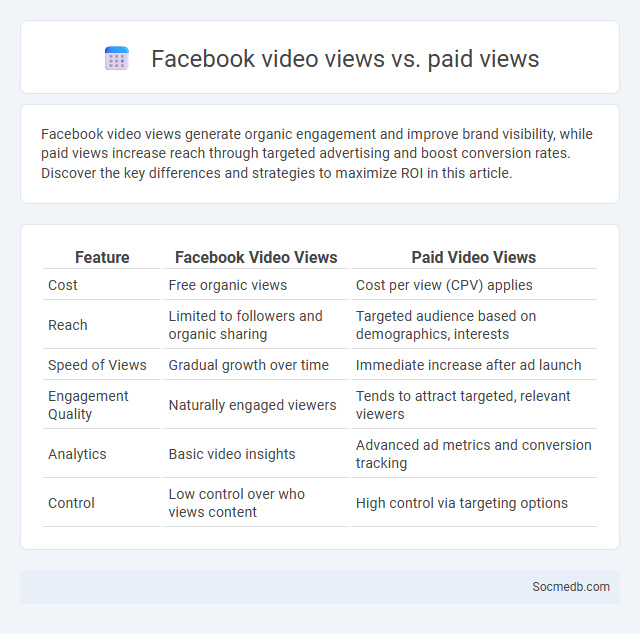
Photo illustration: Facebook Video Views vs Paid Views
Facebook video views generate organic engagement and improve brand visibility, while paid views increase reach through targeted advertising and boost conversion rates. Discover the key differences and strategies to maximize ROI in this article.
Table of Comparison
| Feature | Facebook Video Views | Paid Video Views |
|---|---|---|
| Cost | Free organic views | Cost per view (CPV) applies |
| Reach | Limited to followers and organic sharing | Targeted audience based on demographics, interests |
| Speed of Views | Gradual growth over time | Immediate increase after ad launch |
| Engagement Quality | Naturally engaged viewers | Tends to attract targeted, relevant viewers |
| Analytics | Basic video insights | Advanced ad metrics and conversion tracking |
| Control | Low control over who views content | High control via targeting options |
Understanding Facebook Video Views
Facebook video views are counted when a user watches a video for at least three seconds, reflecting initial engagement metrics. The platform distinguishes between total views, unique views, and average watch time to help creators analyze content performance effectively. Understanding these metrics enables marketers to optimize video content strategy for higher audience retention and improved ad targeting.
What Are Paid Video Views on Facebook?
Paid video views on Facebook refer to the videos that users watch as a result of targeted advertising campaigns, where businesses pay to promote their video content to specific audiences. These paid views help increase your video's reach, engagement, and visibility beyond organic followers, driving higher brand awareness and potential conversion rates. Facebook's advertising platform allows precise targeting based on demographics, interests, and behaviors, ensuring your video content reaches the most relevant viewers.
Differences Between Organic and Paid Video Views
Organic video views on social media occur when users discover and watch content without paid promotion, reflecting genuine engagement and audience interest. Paid video views result from targeted advertising campaigns, leveraging demographic and behavioral data to increase reach and visibility rapidly. Metrics for organic views emphasize authentic interaction rates, while paid views focus on return on ad spend (ROAS) and conversion efficiency.
Defining “Video View” Metrics on Facebook
Facebook's definition of a "Video View" metric captures the number of times a video is watched for at least three seconds or longer, reflecting genuine viewer engagement. This metric helps you accurately gauge the reach and performance of video content on the platform. Understanding nuances like auto-play views and repeat views is crucial for interpreting your social media analytics effectively.
Why Video View Counts Matter for Marketers
Video view counts are a critical metric for marketers because they directly indicate audience engagement and content reach on social media platforms. High view counts boost algorithmic favor, increasing visibility and attracting more potential customers to your brand. Understanding these metrics helps you refine your marketing strategies, allocating resources to the most effective video content for maximum impact.
Facebook’s Algorithm: Organic vs. Paid Views
Facebook's algorithm prioritizes content based on user engagement, which significantly influences organic reach by showing posts to friends or followers more likely to interact with your content. Paid views bypass this natural filtering by directly targeting specific demographics, ensuring a broader or more precise audience is reached. Understanding how your content performs organically can help optimize ad spend and improve your overall Facebook marketing strategy.
How Paid Views Impact Facebook Video Performance
Paid views significantly boost Facebook video performance by increasing visibility and engagement metrics, which help the algorithm recommend your content to a broader audience. When you invest in paid views, the initial spike in watch time, likes, comments, and shares signals to Facebook that your video is valuable, enhancing organic reach. Your strategy should leverage paid views to kickstart momentum, driving sustained interest and higher overall video ranking on the platform.
Optimizing Content for Maximum Video View Engagement
Optimizing content for maximum video view engagement involves crafting compelling titles, thumbnails, and descriptions that resonate with target audiences. Utilizing data analytics to determine peak posting times and audience preferences enhances visibility and interaction rates. Incorporating trends such as interactive elements, captions, and brief yet impactful storytelling significantly boosts viewer retention and social sharing.
Best Practices for Boosting Both Organic and Paid Views
Maximize your social media impact by tailoring content to your target audience's interests and posting consistently during peak engagement times. Utilize A/B testing for paid ads to refine messaging and visuals, ensuring higher click-through rates and better ROI. Harness analytics tools to track performance metrics and adjust strategies, boosting both organic reach and paid visibility effectively.
Measuring Success: Analyzing Video View Analytics on Facebook
Analyzing video view analytics on Facebook provides critical insights into audience engagement, including metrics such as average watch time, reach, and view duration. These data points help marketers optimize content strategy by identifying which videos resonate most with viewers and drive higher interaction rates. Tracking video completion rates alongside click-through rates enables precise measurement of campaign effectiveness and return on investment.
 socmedb.com
socmedb.com